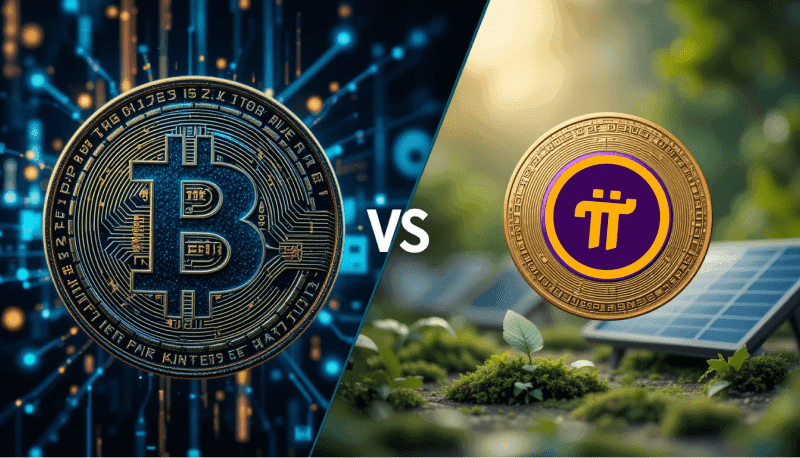Pi vs. Bitcoin: A Comparison of Two Cryptocurrencies
Jan 15, 225
The cryptocurrency space is ever-evolving, offering a variety of projects, each with unique goals and features. Among these, Bitcoin remains the undisputed pioneer and giant, while newer projects like Pi Network aim to make cryptocurrency more accessible to the masses. This article provides an in-depth comparison of Pi and Bitcoin, analyzing their origins, mining processes, network security, market value, energy efficiency, and much more. Let’s dive in to explore the strengths, differences, and potential of these two cryptocurrencies.
1. Introduction
Cryptocurrencies have revolutionized the financial world, introducing decentralized digital assets that bypass traditional banking systems. Bitcoin, introduced in 2009, remains the leader in the space, often referred to as "digital gold." Meanwhile, Pi Network, launched in 2019, seeks to democratize cryptocurrency access through a mobile-friendly, energy-efficient approach. By examining these two distinct projects, we can better understand how they cater to different audiences and solve unique problems in the crypto ecosystem.
2. Origins and Development
Bitcoin (BTC)
Bitcoin, launched in 2009 by the anonymous figure Satoshi Nakamoto, is the first and most widely recognized cryptocurrency. It introduced blockchain technology, a decentralized ledger that records transactions across a distributed network. Bitcoin’s primary goal was to provide a peer-to-peer electronic cash system, eliminating the need for intermediaries.
Pi Network (Pi)
Pi Network, initiated in 2019 by a team of Stanford graduates, takes a different approach. Unlike Bitcoin, which requires specialized hardware for mining, Pi allows users to mine its tokens via a mobile app, ensuring accessibility for the average person. While Pi’s mission to make cryptocurrency mainstream is ambitious, it remains in its early stages, with its full potential yet to be realized.
3. Accessibility and Mining
Bitcoin Mining
Bitcoin mining involves solving complex mathematical puzzles to validate transactions and add them to the blockchain. This process, known as proof-of-work (PoW), is highly resource-intensive, requiring specialized hardware (ASICs) and vast amounts of electricity. As a result, Bitcoin mining is often dominated by large-scale operations, making it inaccessible to everyday users.
Pi Mining
In contrast, Pi Network uses a more user-friendly mining process. The mobile app allows users to mine Pi without draining their phone’s battery or using significant computational resources. This approach lowers the barrier to entry, attracting users who may not have access to expensive mining equipment. However, Pi’s mining system has faced skepticism regarding its long-term scalability and security.
4. Decentralization and Security
Bitcoin
Bitcoin’s network is highly decentralized, with thousands of nodes operating globally. This decentralization, combined with its PoW consensus mechanism, makes Bitcoin extremely secure against attacks. However, the energy demands of PoW remain a concern, drawing criticism from environmental advocates.
Pi Network
Pi uses the Stellar Consensus Protocol (SCP), which is less energy-intensive than Bitcoin’s PoW. However, Pi’s network is still in its centralized phase, with its core team retaining control during development. While this approach allows for faster decision-making, it raises questions about the project’s commitment to decentralization.
5. Market Value and Adoption
Bitcoin
Bitcoin is the most valuable cryptocurrency, with a market capitalization exceeding $500 billion. It is widely adopted by institutional investors, retailers, and individuals, solidifying its reputation as a store of value and an alternative to traditional assets like gold.
Pi Network
As of now, Pi has no established market value, as it is still in its testing phase. Its future success hinges on the launch of its mainnet and its ability to deliver on promised use cases. This speculative nature makes it a high-risk project compared to Bitcoin.
6. Use Cases
Bitcoin
Bitcoin’s primary use case is as a store of value and an alternative investment. While it can be used for transactions, its slow transaction speed and high fees limit its practicality for everyday purchases.
Pi Network
Pi aims to create a peer-to-peer marketplace, enabling users to exchange goods and services using Pi tokens. However, these use cases remain theoretical until Pi achieves wider adoption and real-world integration.
7. Energy Consumption and Environmental Impact
Bitcoin
Bitcoin’s energy consumption has been a subject of intense scrutiny, with estimates suggesting it consumes as much electricity as small countries like Argentina. Critics argue that this environmental impact could hinder its long-term adoption.
Pi Network
Pi’s mining process is lightweight and energy-efficient, making it more appealing to environmentally-conscious users. However, whether this model can sustain a large-scale network remains uncertain.
FAQs
1. What is the main difference between Bitcoin and Pi Network?
Bitcoin is a well-established cryptocurrency with a proven track record, while Pi Network is still in its developmental phase, aiming to offer a more accessible and eco-friendly alternative.
2. Can I trade Pi tokens like Bitcoin?
Not yet. Pi tokens are currently not listed on public exchanges, as the network is still in its testing phase.
3. Is Pi Network secure?
Pi uses the Stellar Consensus Protocol for security but remains largely centralized during its development phase, unlike Bitcoin, which is highly decentralized.
4. Which cryptocurrency is better for beginners?
Pi Network is more beginner-friendly due to its mobile app and energy-efficient mining process, whereas Bitcoin requires more technical knowledge and resources.
5. Does Pi have any market value?
No, Pi does not currently have a market value, as it is still in the testing phase. Its value will depend on its success post-mainnet launch.
6. What are the environmental impacts of Bitcoin and Pi?
Bitcoin’s mining process is energy-intensive, contributing to environmental concerns, while Pi’s energy-efficient model aims to address these issues.
Conclusion
While Bitcoin continues to dominate the cryptocurrency landscape as a trusted and valuable asset, Pi Network seeks to democratize access to digital currencies with its innovative and sustainable approach. Both projects serve different purposes and audiences, making them valuable in their unique ways. As Pi progresses toward full launch, it will be interesting to see whether it can live up to its potential and compete with established giants like Bitcoin.

Pi Network Token Crash Raises Transparency Concerns

Pi Network Coin Gains Momentum in Crypto Market

Binance Pi Network Listing Rumors Spark After Logo Clue and Blockchain Activity

Pi Network Price Surge: What’s Driving the 33% Spike in PI Token Value?

Pi Coin Trading Halted | BitMart & Banxa Delisting News

Pi Coin Price Prediction 2025: Chainlink Integration Fuels 228% Surge Forecast to $2.50

Pi Network Price Surge: Chart Signals a Potential 135% Bullish Breakout

Why KYB Compliance Is Key for Exchanges Eyeing Pi Network Market Entry

Pi Ad Network Expansion: Now Open to All Ecosystem Listed Pi Apps

Pi Network Price Drops to All-Time Lows as Supply Pressure Builds

